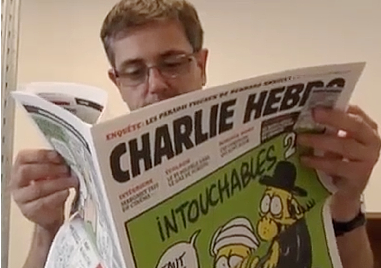On the morning of a devastating attack on the offices of Charlie Hebdo in Paris, we offer profound condolences to the families of those killed and the worldwide community of journalists. Here, below, is a piece from two years ago, a bittersweet reflection from a fellow French journalist on the occasion of a previous controversy.
_____________
When you are on a pile of powder, you don’t scratch a match and call it liberty.
—Daniel Cohn-Bendit, icon of the ’68 student movement, 9/21/12
Why on earth is an orthodox Jew pushing a turbaned Muslim man in a wheelchair on the cover of Charlie Hebdo, the French baby-boomers’ favorite satirical magazine? Don’t bother looking for any deep symbolism—you won’t find it.
Anybody in France immediately recognized the resemblance to the poster for Intouchables (The Untouchables), which came out almost a year ago and sold twenty million tickets in France (and nearly as many abroad). Intouchables is a funny and moving comedy, but as politically correct a story as you’ll find: a black young man bordering on delinquency is hired by a tetraplegic wealthy man to be his assistant-nurse-chauffeur. They have a ball together doing crazy—and sometimes nasty—things, and save each other from an apparently inexorable fate.
Charlie Hebdo (named after Charles Schulz’s character in the comic strip Peanuts), is as politically incorrect a magazine as can be, beyond imaginable for most Americans. Its first issue came out in 1970, after its predecessor (called Hara-Kiri Hebdo) was shut down by the French censorship bureau because of a politically blasphemous headline. General de Gaulle, former French president and World War II hero, had just passed away in his country home in Colombey-les-deux-églises a few days after 146 young people perished in a huge fire that burned down a nightclub. Hara-Kiri Hebdo had come out with the headline: “Tragic party in Colombey: one dead”.
Resurrected soon after the ban under the new name Charlie Hebdo, the magazine was our weekly delight; I mean we, post-’68 students in Paris. Its reporters were such naughty, nasty, funny boys; such talented cartoonists, such incredible columnists. Of course, they hated any kind of bigotry and specialized in sexually explicit, anti-religious jokes and cartoons. Want to hear one? (And you should see it, too, as it was the cover picture of the December 16, 1976 issue, a friend of mine dug it out of his archives today.) Headine: “Virgin Mary raped by the Wise men.” In the accompanying cartoon, the weeping Mary adds: “Three of them, and one was black!”
 In France, such jokes have long been accepted, and even relished. They mainly target the Catholic Church, especially the Pope, bishops, and priests, but also sacred figures such as Jesus or Mary. Jewish and Muslim bigots were gradually included, and this continued without any consequence for thirty years or so—except for some regular whining by offended faithful. Then came 9/11, followed four years later by the global outburst of violence after a Danish newspaper published cartoons mocking Muhammad, and then, in November 2011, Charlie Hebdo’s headquarters were burned down after it published caricatures of Muhammad.
In France, such jokes have long been accepted, and even relished. They mainly target the Catholic Church, especially the Pope, bishops, and priests, but also sacred figures such as Jesus or Mary. Jewish and Muslim bigots were gradually included, and this continued without any consequence for thirty years or so—except for some regular whining by offended faithful. Then came 9/11, followed four years later by the global outburst of violence after a Danish newspaper published cartoons mocking Muhammad, and then, in November 2011, Charlie Hebdo’s headquarters were burned down after it published caricatures of Muhammad.
Charlie Hebdo never stopped publishing this type of cartoon, but it gradually lost readers. A new generation leads the magazine and people like me now hardly ever buy it. Times have changed, the humor has changed; the nastiness that used to make us laugh our heads off doesn’t seem as funny these days. Perhaps because reality has turned bloody, for good.
Pathetically, the left-wing radical magazine that once mocked left-wing radicals—as well as everyone else—has turned somewhat sour. It only seems to sell papers when it insults Muslims and plays with the lives of anonymous people (as well as its own reporters’).
In today’s Le Monde, Charb, the director of Charlie Hebdo, declared: “It may sound pompous, but I’d rather die standing than live on my knees.” Should a cartoonist become some kind of priest, leading a sacrificial ritual on the altar of freedom of speech? To what avail?





